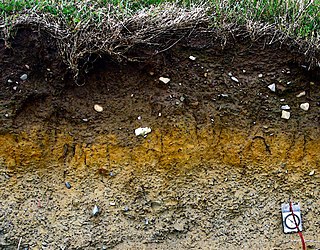Related Research Articles

In classical soil science, humus is the dark organic matter in soil that is formed by the decomposition of plant and animal matter. It is a kind of soil organic matter. It is rich in nutrients and retains moisture in the soil. Humus is the Latin word for "earth" or "ground".

Soil, also commonly referred to as earth or dirt, is a mixture of organic matter, minerals, gases, liquids, and organisms that together support life. Some scientific definitions distinguish dirt from soil by restricting the former term specifically to displaced soil.

The pyrolysis process is the thermal decomposition of materials at elevated temperatures, often in an inert atmosphere. It involves a change of chemical composition. The word is coined from the Greek-derived elements pyro "fire", "heat", "fever" and lysis "separating".
Thiophene is a heterocyclic compound with the formula C4H4S. Consisting of a planar five-membered ring, it is aromatic as indicated by its extensive substitution reactions. It is a colorless liquid with a benzene-like odor. In most of its reactions, it resembles benzene. Compounds analogous to thiophene include furan (C4H4O), selenophene (C4H4Se) and pyrrole (C4H4NH), which each vary by the heteroatom in the ring.
Green chemistry, similar to sustainable chemistry or circular chemistry, is an area of chemistry and chemical engineering focused on the design of products and processes that minimize or eliminate the use and generation of hazardous substances. While environmental chemistry focuses on the effects of polluting chemicals on nature, green chemistry focuses on the environmental impact of chemistry, including lowering consumption of nonrenewable resources and technological approaches for preventing pollution.
Humic substances (HS) are organic compounds that are important components of humus, the major organic fraction of soil, peat, and coal. For a long era in the 19th and 20th centuries, humic substances were often viewed through a lens of acid–base theory that described humic acids (HA), as organic acids, and their conjugate bases, humates, as important components of organic matter. Through this viewpoint humic acids were defined as organic substances extracted from soil that coagulate when a strong-base extract is acidified, whereas fulvic acids (FA) are organic acids that remain soluble when a strong-base extract is acidified. The remaining alkali-insoluble part of humus would be termed humin.

Phytoremediation technologies use living plants to clean up soil, air and water contaminated with hazardous contaminants. It is defined as "the use of green plants and the associated microorganisms, along with proper soil amendments and agronomic techniques to either contain, remove or render toxic environmental contaminants harmless". The term is an amalgam of the Greek phyto (plant) and Latin remedium. Although attractive for its cost, phytoremediation has not been demonstrated to redress any significant environmental challenge to the extent that contaminated space has been reclaimed.
Organic matter, organic material, or natural organic matter refers to the large source of carbon-based compounds found within natural and engineered, terrestrial, and aquatic environments. It is matter composed of organic compounds that have come from the feces and remains of organisms such as plants and animals. Organic molecules can also be made by chemical reactions that do not involve life. Basic structures are created from cellulose, tannin, cutin, and lignin, along with other various proteins, lipids, and carbohydrates. Organic matter is very important in the movement of nutrients in the environment and plays a role in water retention on the surface of the planet.

A biorefinery is a refinery that converts biomass to energy and other beneficial byproducts. The International Energy Agency Bioenergy Task 42 defined biorefining as "the sustainable processing of biomass into a spectrum of bio-based products and bioenergy ". As refineries, biorefineries can provide multiple chemicals by fractioning an initial raw material (biomass) into multiple intermediates that can be further converted into value-added products. Each refining phase is also referred to as a "cascading phase". The use of biomass as feedstock can provide a benefit by reducing the impacts on the environment, as lower pollutants emissions and reduction in the emissions of hazard products. In addition, biorefineries are intended to achieve the following goals:
- Supply the current fuels and chemical building blocks
- Supply new building blocks for the production of novel materials with disruptive characteristics
- Creation of new jobs, including rural areas
- Valorization of waste
- Achieve the ultimate goal of reducing GHG emissions

Hydroxymethylfurfural (HMF), also 5-(hydroxymethyl)furfural, is an organic compound formed by the dehydration of reducing sugars. It is a white low-melting solid which is highly soluble in both water and organic solvents. The molecule consists of a furan ring, containing both aldehyde and alcohol functional groups.

Levulinic acid, or 4-oxopentanoic acid, is an organic compound with the formula CH3C(O)CH2CH2CO2H. It is classified as a keto acid. This white crystalline solid is soluble in water and polar organic solvents. It is derived from degradation of cellulose and is a potential precursor to biofuels, such as ethyl levulinate.

The Stevens rearrangement in organic chemistry is an organic reaction converting quaternary ammonium salts and sulfonium salts to the corresponding amines or sulfides in presence of a strong base in a 1,2-rearrangement.

The microbial loop describes a trophic pathway where, in aquatic systems, dissolved organic carbon (DOC) is returned to higher trophic levels via its incorporation into bacterial biomass, and then coupled with the classic food chain formed by phytoplankton-zooplankton-nekton. In soil systems, the microbial loop refers to soil carbon. The term microbial loop was coined by Farooq Azam, Tom Fenchel et al. in 1983 to include the role played by bacteria in the carbon and nutrient cycles of the marine environment.

2,5-Furandicarboxylic acid (FDCA) is an organic chemical compound consisting of two carboxylic acid groups attached to a central furan ring. It was first reported as dehydromucic acid by Rudolph Fittig and Heinzelmann in 1876, who produced it via the action of concentrated hydrobromic acid upon mucic acid. It can be produced from certain carbohydrates and as such is a renewable resource, it was identified by the US Department of Energy as one of 12 priority chemicals for establishing the “green” chemistry industry of the future. Furan-2,5-dicarboxylic acid (FDCA) has been suggested as an important renewable building block because it can substitute for terephthalic acid (PTA) in the production of polyesters and other current polymers containing an aromatic moiety.
In chemistry, solvent effects are the influence of a solvent on chemical reactivity or molecular associations. Solvents can have an effect on solubility, stability and reaction rates and choosing the appropriate solvent allows for thermodynamic and kinetic control over a chemical reaction.

Sea foam, ocean foam, beach foam, or spume is a type of foam created by the agitation of seawater, particularly when it contains higher concentrations of dissolved organic matter derived from sources such as the offshore breakdown of algal blooms. These compounds can act as surfactants or foaming agents. As the seawater is churned by breaking waves in the surf zone adjacent to the shore, the surfactants under these turbulent conditions trap air, forming persistent bubbles that stick to each other through surface tension.

2,5-Bis(hydroxymethyl)furan (BHMF) is a heterocyclic organic compound, and is a derivative of a broader class of compounds known as furans. It is produced from cellulose and has received attention as a biofeedstock. It is a white solid, although commercial samples can appear yellowish or tan.

Methoxymethylfurfural is an organic compound derived from dehydration of sugars and subsequent etherification with methanol. This colorless liquid is soluble in a wide range of solvents including lower alcohols. The molecule is a derivative of furan, containing both aldehyde and ether (methoxymethyl) functional groups. MMF has been detected in the leaves and roots of Chilean Jaborosa magellanica (Solanaceae). It has a typical odor suggestive of maraschino cherries. MMF can be made from a wide range of carbohydrate containing feedstocks including sugar, starch and cellulose using a chemical catalytic process and is a potential "carbon-neutral" feedstock for fuels and chemicals.
In organic chemistry, ketonic decarboxylation is a type of organic reaction and a decarboxylation converting two equivalents of a carboxylic acid to a symmetric ketone by the application of heat. Water and carbon dioxide are byproducts:

Particulate organic matter (POM) is a fraction of total organic matter operationally defined as that which does not pass through a filter pore size that typically ranges in size from 0.053 to 2 millimeters.
References
- ↑ Rice, James A. "Humin" Soil Science 2001, vol. 166(11), pp. 848-857. doi : 10.1097/00010694-200111000-00002
- ↑ Lehmann, J.; Kleber, M. (2015-12-03), "The contentious nature of soil organic matter", Nature, 528 (7580): 60–68, doi: 10.1038/nature16069 , PMID 26595271
- ↑ van Zandvoort, I., "Towards the Valorisation of Humin By-products: Characterisation, Solubilisation and Catalysis", 2015
- ↑ Heltzel, Jacob; Patil, Sushil K. R.; Lund, Carl R. F. (2016), Schlaf, Marcel; Zhang, Z. Conrad (eds.), "Humin Formation Pathways", Reaction Pathways and Mechanisms in Thermocatalytic Biomass Conversion II: Homogeneously Catalyzed Transformations, Acrylics from Biomass, Theoretical Aspects, Lignin Valorization and Pyrolysis Pathways, Green Chemistry and Sustainable Technology, Springer Singapore, pp. 105–118, doi:10.1007/978-981-287-769-7_5, ISBN 9789812877697
- ↑ Horvat, Jaroslav; Klaić, Branimir; Metelko, Biserka; Šunjić, Vitomir (1985-01-01). "Mechanism of levulinic acid formation". Tetrahedron Letters. 26 (17): 2111–2114. doi:10.1016/S0040-4039(00)94793-2. ISSN 0040-4039.
- ↑ Sumerskii, I. V.; Krutov, S. M.; Zarubin, M. Ya. (2010-02-01). "Humin-like substances formed under the conditions of industrial hydrolysis of wood". Russian Journal of Applied Chemistry. 83 (2): 320–327. doi:10.1134/S1070427210020266. ISSN 1608-3296. S2CID 84984623.
- ↑ Luijkx, Gerard C. A.; van Rantwijk, Fred; van Bekkum, Herman (1993-04-07). "Hydrothermal formation of 1,2,4-benzenetriol from 5-hydroxymethyl-2-furaldehyde and d-fructose". Carbohydrate Research. 242: 131–139. doi:10.1016/0008-6215(93)80027-C. ISSN 0008-6215.
- 1 2 Muralidhara, A., Tosi, P., Mija, A., Sbirrazzuoli, N., Len, C., Engelen, V., de Jong, E., Marlair, G., ACS Sustainable Chem. Eng., 2018, 6, 16692-16701
- ↑ Muralidhara, A., Bado-Nilles, A., Marlair, G., Engelen, V., Len, C., Pandard, P., Biofuels, Bioproducts and Biorefining, 2018, 1-7
- ↑ Tosi, Pierluigi; van Klink, Gerard P. M.; Celzard, Alain; Fierro, Vanessa; Vincent, Luc; de Jong, Ed; Mija, Alice (2018). "Auto-Crosslinked Rigid Foams Derived from Biorefinery Byproducts". ChemSusChem. 11 (16): 2797–2809. doi:10.1002/cssc.201800778. ISSN 1864-564X. PMC 6392144 . PMID 29956889.
- ↑ Filiciotto, L., Balu, A.M., Romero, A.A, Rodriguez-Castellon, E., van der Waal, J.C., Luque, R., Green Chemistry, 2017, 19, 4423-4434
- ↑ Mija, A., van der Waal, J.C., Pin, J-M., Guigo, N., de Jong, E., "Humins as promising material for producing sustainable carbohydrate-derived building materials", Construction and Building Materials, 2017, 139, 594 doi : 10.1016/j.conbuildmat.2016.11.019
- ↑ Sangregorio, A., Guigo, N., van der Waal, J.C., Sbirrazzuoli, N., "All 'green' composites comprising flax fibres and humins' resins", Composites Science and Technology, 2019, 171, 70. doi : 10.1016/j.compscitech.2018.12.008
- ↑ Pin, J.M., Guigo, N., Mija, A., Vincent, L., Sbirrazzuoli, N., van der Waal, J.C., de Jong, E., ACS Sustain. Chem. Eng., 2014, 2, 2182-2190
- ↑ Mija, A., van der Waal, J.C., van Klink, G., de Jong, E., Humins-containing foam, 2016, WO2017074183A8
- ↑ Tosi, P., van Klink, G.P., Celzard, A., Fierro V., Vincent, L., de Jong, E., Mija, A., ChemSusChem, 2018, 11, 2797-2809